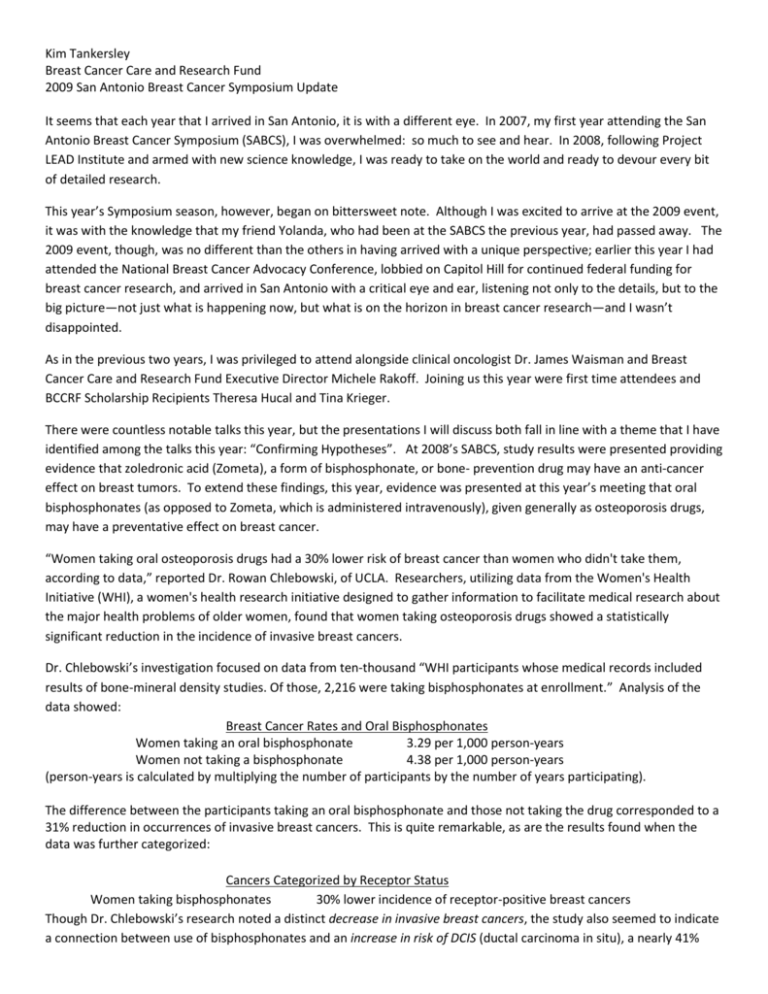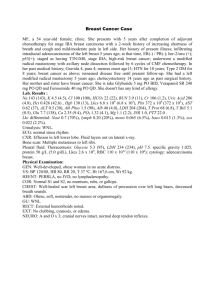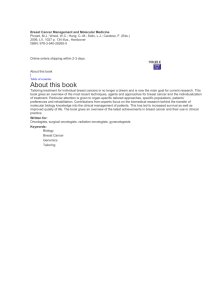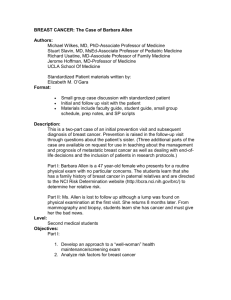Event Info - Breast Cancer Care & Research Fund
advertisement

Kim Tankersley Breast Cancer Care and Research Fund 2009 San Antonio Breast Cancer Symposium Update It seems that each year that I arrived in San Antonio, it is with a different eye. In 2007, my first year attending the San Antonio Breast Cancer Symposium (SABCS), I was overwhelmed: so much to see and hear. In 2008, following Project LEAD Institute and armed with new science knowledge, I was ready to take on the world and ready to devour every bit of detailed research. This year’s Symposium season, however, began on bittersweet note. Although I was excited to arrive at the 2009 event, it was with the knowledge that my friend Yolanda, who had been at the SABCS the previous year, had passed away. The 2009 event, though, was no different than the others in having arrived with a unique perspective; earlier this year I had attended the National Breast Cancer Advocacy Conference, lobbied on Capitol Hill for continued federal funding for breast cancer research, and arrived in San Antonio with a critical eye and ear, listening not only to the details, but to the big picture—not just what is happening now, but what is on the horizon in breast cancer research—and I wasn’t disappointed. As in the previous two years, I was privileged to attend alongside clinical oncologist Dr. James Waisman and Breast Cancer Care and Research Fund Executive Director Michele Rakoff. Joining us this year were first time attendees and BCCRF Scholarship Recipients Theresa Hucal and Tina Krieger. There were countless notable talks this year, but the presentations I will discuss both fall in line with a theme that I have identified among the talks this year: “Confirming Hypotheses”. At 2008’s SABCS, study results were presented providing evidence that zoledronic acid (Zometa), a form of bisphosphonate, or bone- prevention drug may have an anti-cancer effect on breast tumors. To extend these findings, this year, evidence was presented at this year’s meeting that oral bisphosphonates (as opposed to Zometa, which is administered intravenously), given generally as osteoporosis drugs, may have a preventative effect on breast cancer. “Women taking oral osteoporosis drugs had a 30% lower risk of breast cancer than women who didn't take them, according to data,” reported Dr. Rowan Chlebowski, of UCLA. Researchers, utilizing data from the Women's Health Initiative (WHI), a women's health research initiative designed to gather information to facilitate medical research about the major health problems of older women, found that women taking osteoporosis drugs showed a statistically significant reduction in the incidence of invasive breast cancers. Dr. Chlebowski’s investigation focused on data from ten-thousand “WHI participants whose medical records included results of bone-mineral density studies. Of those, 2,216 were taking bisphosphonates at enrollment.” Analysis of the data showed: Breast Cancer Rates and Oral Bisphosphonates Women taking an oral bisphosphonate 3.29 per 1,000 person-years Women not taking a bisphosphonate 4.38 per 1,000 person-years (person-years is calculated by multiplying the number of participants by the number of years participating). The difference between the participants taking an oral bisphosphonate and those not taking the drug corresponded to a 31% reduction in occurrences of invasive breast cancers. This is quite remarkable, as are the results found when the data was further categorized: Cancers Categorized by Receptor Status Women taking bisphosphonates 30% lower incidence of receptor-positive breast cancers Though Dr. Chlebowski’s research noted a distinct decrease in invasive breast cancers, the study also seemed to indicate a connection between use of bisphosphonates and an increase in risk of DCIS (ductal carcinoma in situ), a nearly 41% greater incidence over women who were not taking the drug. At this stage, there is not yet a justification or explanation for this finding. This “could mean that bisphosphonates prevent invasive but not in situ breast cancer, prevent the progression of in situ cancer to invasive cancer, or something entirely different,” according to Dr. Chlebowski. Because this was a “retrospective study,” meaning that past data was analyzed, we must be optimistically cautious in recognizing the role of oral bisphosphonates in the prevention of breast cancer. With the positive findings of Dr. Chlebowski and his colleagues, we will probably see follow-up “prospective” studies designed to corroborate, and hopefully, validate, the value of bisphosphonates as more than a treatment for osteoporosis. In addition to Dr. Chlebowski’s results, other promising results abounded. Following my 2007 visit to San Antonio, I reported on Dr. Kathy Albain’s studies on the 21-gene recurrence-score assays and their prognostic value. As I have previously described, Oncotype Dx, a 21-gene recurrence-score assay, was developed by Genomic Health to predict which patients with estrogen-positive breast cancer could avoid being treated with chemotherapy. Through an examination of the genomic profile of one’s tumor, it can sometimes be determined how a patient will respond to a particular treatment, rather than “waiting to see” whether the patient will have a response to treatments generally targeted toward a particular type of breast cancer. Of the 21 genes profiled, 16 of the genes in the test are cancerrelated, including those related to estrogen receptor and HER2. Dr. Albain, in tandem with the Southwest Oncology Group (SWOG), has continued to examine the prognostic value of the Oncotype Dx assay in several cohort groupings; one such study utilized the assay to identify the likelihood of a response to the CAF chemotherapy regimen—cyclophosphamide (Cytoxan) + doxorubicin (Adriamycin) + Fluorouracil (5FU)—based on a tumor’s Oncotype Dx Recurrence Score. Oncotype Dx had, in previous studies, been shown to have predictive value for patients with node-negative, ER+ breast cancer and treated with tamoxifen. This time, Dr. Albain examined node-positive SWOG-8814 patients treated with both tamoxifen alone and patients treated with the chemotherapy regimen plus tamoxifen. In the course of the study, researchers searched for a relationship between a patient’s recurrence score and disease-free survival by comparing the two groups: those receiving tamoxifen and those treated with the CAF + tamoxifen). Evidence showed that chemotherapy, in supplement to tamoxifen, either concurrently or sequentially, provided a notably improved disease free survival rate of 57% over tamoxifen alone, which indicated a rate of 48%. Understanding the prognostic factor of the Recurrence Score in this study is important. Please reference the chart below to be aware of the scores indicative of each category: Recurrence Score Breakdown Low Risk Score Less than 18 Intermediate Risk 18–30 High Risk 31 or Higher Albain’s group has found that low recurrence scores, those lower than 18, seem to identify women who "might not benefit from anthracycline-based chemotherapy, despite positive nodes.” Conversely, results showed that lower spectrum scores predicted no benefit from the chemotherapy in regards to disease free survival. Dr. Albain and her colleagues conclude that ”the recurrence score predicts significant benefit of CAF in patients with tumors with a high recurrence score.” It appears, then, that only those with recurrence scores in the “high risk” range of 31 or greater will benefit from the chemotherapy regimen. Knowing that patients on the low-end of the recurrence score spectrum did not benefit from the chemotherapy regimen could be an indicator that without the prognostic test, some patients, primarily those that are node-negative, could find themselves at risk for unnecessary treatment and unwarranted and potentially toxic exposure. Obviously the standard of treatment should always be first and foremost followed, however, the benefits must always outweigh the risks, and if we can determine such with a tissue sample, prior to treatment-decision making, that would be advantageous to most patients. Each year of the Symposium appears to define itself with a sort of global theme. In 2009, the theme of “Confirming Hypotheses” seemed to prevail. We saw updated, wider-range results from on-going studies that had already established efficacy of new treatments, reconfirming previous research results—and also, updates of ongoing studies that show what isn’t working. Thus, the paradigm shift continues towards targeting subtypes, targeted therapies, targeting pathways. Targets, targets, targets! Considering individualized treatments, genomic profiling, and educated predictions, in combination with health care reform, more research, better treatments, and greater availability—each year finds us that much closer to our goal of eradicating breast cancer. Chlebowski R, et al "Oral bisphosphonates and breast cancer: Prospective results from the Women's Health Initiative (WHI)" SABCS 2009; Abstract 21. Albain K, et al, "Prediction of 10-year chemotherapy benefit and breast cancer-specific survival by the 21-gene Recurrence Score (RS) assay in node-positive, ER-positive breast cancer - An update of SWOG-8814 (INT0100)" SABCS 2009; Abstract 112








